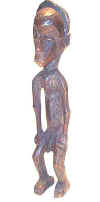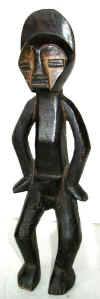 |
 |
TRIBAL AFRICAN ART
MBOLE (BAMBOLE)
Democratic Republic of the Congo
The 150,000 Mbole get their name from their position vis-à-vie the river; “Mbole” means “the people from downstream”. They live on the left bank of the Zaire River, in the heart of the Democratic Republic of the Congo. They migrated to this forest region from the north of the Lualaba River during the 18th century. Politically each Mbole village is autonomous, headed by a chief chosen from the elders of each family. The women of the tribe are involved mainly in cultivating manioc and rice while the men hunt. Lilwa (libwe), a graded men's organization, dominates Mbole life. It supervises ritual, educational, judicial, social, political, and economic functions. Boys of seven to twelve years old are isolated in the forest for circumcision and initiation, undergoing ritual purification and proving themselves through ordeals and fasting. The head of the lilwa society, known as Isoya, is so important that he is buried in a tree and his village hut is kept empty.
The Mbole are known principally for their figures known as ofika which tend to be categorized by their geometric features, elongated emaciated bodies, enlarged heads with heart-shaped faces, protruding mouths and crown-like coiffures. The shoulders and arms seem inert and uncontrolled. White pigment is applied to the face of the statue. Ofika figures represent men or women who were hanged for transgressing the moral and legal laws of the lilwa. Such figures were shown to youths during their initiation into the association to illustrate the consequence of immoral conduct and also to instill in them respect for the authority vested in elders and ranking lilwa members. An initiation was given to young boys who had already learned to fish (taught by women) and farm (taught by men). The children would be taken into the bush to develop their qualities of endurance, courage, loyalty, and discipline; they underwent trials of fasting and learned the language of the lilwa and its secrets. Abstract, polychrome masks were used during the closing rite, when the statues would be ceremonially brought out. The figures symbolized the power and authority of the lilwa and were the exclusive prerogative of high-ranking members. Ofika were displayed on other solemn occasions, such as during executions by hanging, during periods of persistent bad hunting, when oaths were taken, and when serious conflicts between parties were settled. Each ofika bears the name of a hanged individual.